A Cultural Culinary Getaway in Messolonghi
A brave history and uniquely beautiful...
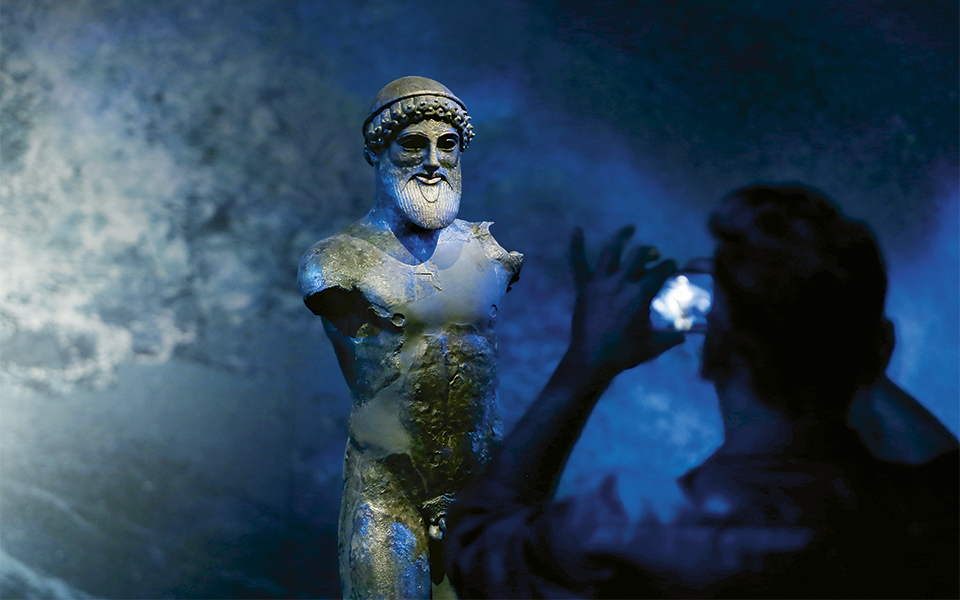
Bronze statue of Poseidon, found in the sea near Livadostra in Viotia, the port of Plataea, and dating back to 480 BC, as displayed in the temporary exhibition “Odysseys” that celebrates the National Archaeological Museum’s 150th anniversary.
© Getty Image/Ideal Image
These days, it seems we look forward so much to a “futuristic” future, and have become so enthralled with electronic devices and a digital, “virtual” world, that old ways and traditional concepts are often viewed, especially by young people, as something odd or out of sync with the times. Fewer Western student-travelers are taking “grand tours” to the classical world’s oldest cities and lands, like modern-day Lord Byrons, Charles Cockerells, or Sanford Giffords, in search of tangible, inspiring traces of their historical, cultural roots.
Nevertheless, Athens and other European “cultural capitals” are the original 3D historical sites, where visitors of all ages can actually connect with the past in ways unlike those of any virtual tour hyped online. In today’s rapidly changing world, it is more important than ever to comprehend the depth and breadth of past human achievement and learning, as we can never fully appreciate the present, or even conceive of the future, without first understanding the past.
Firsthand exploration of Athens (as of any large city) can require stamina and determination, but this is all part of the “journey,” as one follows a trail of archaeological discovery that imparts what it truly means, and has meant for thousands of years, to be a feeling, thinking, creatively expressive human being. Athens offers a panoply of historical, architectural and artistic riches, from majestic ruins and golden artifacts to simple grave enclosures, overgrown ancient streams and panoramic hilltop views. Often, it is the city’s humbler monuments and less conspicuous sights that “speak” to us in the clearest voice.
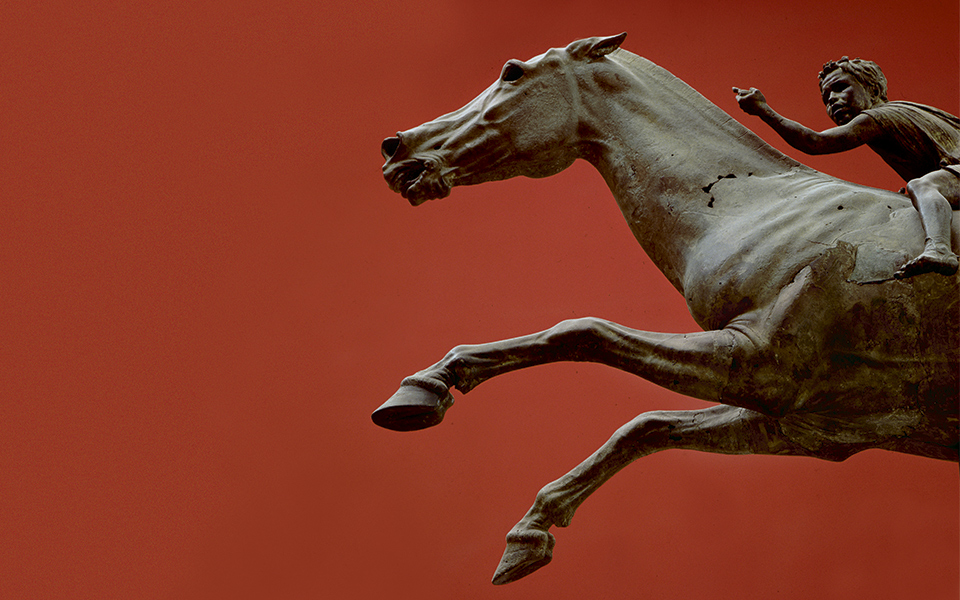
Jockey of Artemision (Hellenistic, circa 140 BC). This outstanding bronze statue has a height of 2.10m and was recovered in pieces from the seabed off Cape Artemision, northern Evia, in 1928 and 1937. The young rider, possibly African, would have held the reins of the galloping horse in his left hand and a whip in his right. The rendering of his puckered face reveals agitation and passion.
Athenian museums, an essential starting point on any tour, just get better and better. Through them, visitors come face to face with the full scope of Greek history and culture, from prehistoric times through to the present day. The National Archaeological Museum (NAM), the mother ship of the city’s museums, turned 150 years old in October 2016. As part of its festivities, NAM mounted an exhibition, “Odysseys,” running through the end of September 2017, which presents nearly 200 artifacts garnered from both the museum’s permanent galleries and the cloistered recesses of its back rooms.
Most impressive, besides the statues, painted vases and other objects themselves, is the creativity and progressiveness expressed by the exhibition’s designers. Through displays such as this one, as well as its previous Antikythera Wreck exhibition that was extended by popular demand, NAM continues to show that it is no staid national museum willing to rest on the laurels of its permanent collections.
The “Odysseys” exhibition is an experiential, thought-provoking, thematic presentation, which follows the tale of Homer’s timeless character, but uses his adventures and struggles as a point of departure to address larger issues, including man’s quest for knowledge and scope for achievement, as well as the themes of prosperity, seafaring and homecoming.
The added atmospheric effects of pleasant music, blue sea-like lighting and the words of great modern Greek poets inspired by Homer make “Odysseys” a must-see. And don’t miss NAM’s world-famous attractions, including the “Mask of Agamemnon,” the well-muscled Kouros figures, the serenely powerful Zeus/Poseidon, the colorful, naturalistic wall paintings from Santorini and an array of individualistic portraits and larger marble statues from Hellenistic and Roman times.
National Archaiological Museum
44 Patission, Tel. (+30) 213.214.4800
Open: Mon 13:00-20:00, Tue-Sun: 08:00-20:00
General admission: 10€
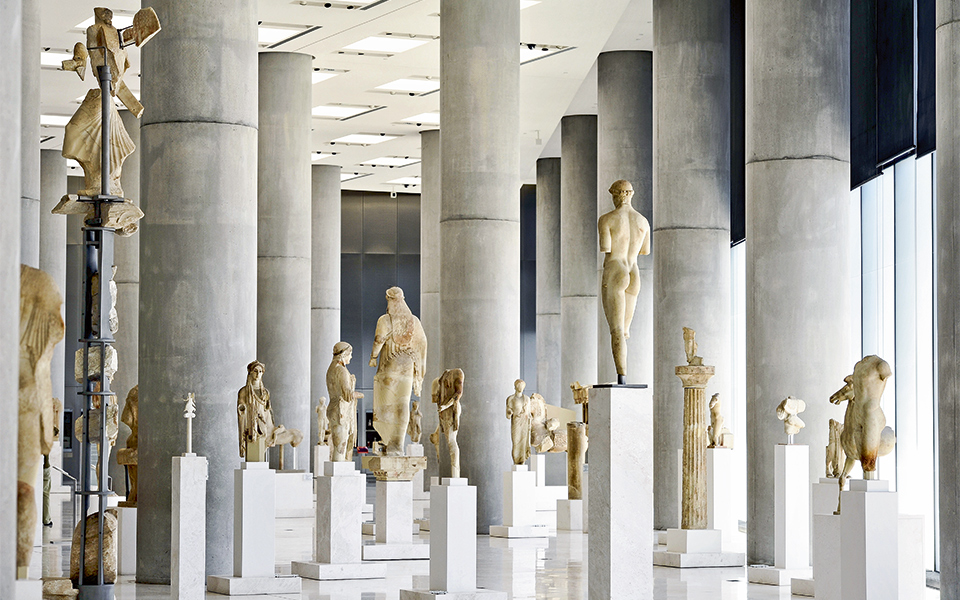
In the Archaic Acropolis Gallery, visitors can see all sides of the free-standing sculptures in order to better appreciate their craftsmanship and beauty.
© Vangelis Zavos
At the Acropolis Museum, voted 9th best in the world by TripAdvisor users, one ascends the ramp of the Acropolis Slopes Gallery just as they might climb the Sacred Rock itself. With delights around every corner, visitors are treated to such Archaic and Classical sculpture masterpieces as the Calf Bearer, the Peplos Kore, the Kritios Boy and the flowing-robed Nike Adjusting Her Sandal.
Crowning the ultra-modern museum is the Parthenon Gallery, where one sees up close the temple’s amazing Ionic frieze and metope panels with their finely carved scenes of gods, knights, offering-bearers and drunken, lecherous centaurs. Through enormous glass windows, visitors have a visual connection with the actual Parthenon, the gleaming, newly restored Thrasyllus Monument and other gems of the Acropolis.
15 Dionysiou Areopagitou, tel. (+30) 210.900.0900
Open: Mon 8:00-16:00, Fri 8:00-22:00, Tue-Thu & Sat-Sun 8:00-20:00
General admission: €5
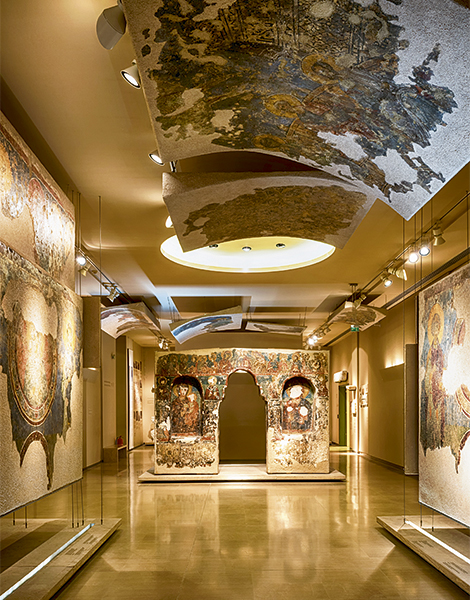
Wall paintings and (background) the masonrybuilt 17th-c. iconostasis of the Church of the Assumption of the Virgin (Diocese) of Evrytania. The iconostasis features depictions of the Great Prayer (Megali Deisi), Christ Pantocrator, Panagia Odigitria and saints.
© Perikles Merakos
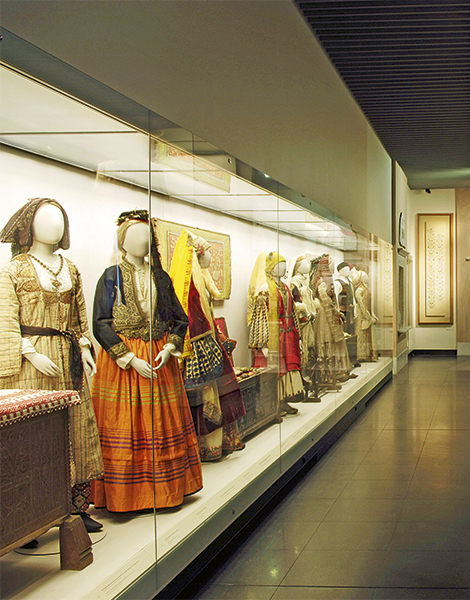
A display of traditional costumes from various regions of Greece.
Housed in the Villa Ilissia, one of the most beautiful 19th-century buildings erected in the young capital of the modern Greek State, the Byzantine and Christian Museum (BCM) offers a different historical perspective, with lavish displays of Early Christian, medieval and early modern artifacts, icons and other church-related items.
The BCM’s dramatic, cutting-edge displays and informative signage draw visitors into the fascinating world of Byzantium and Orthodoxy. Not to be missed is the temporary exhibition titled “100 Years Art Group,” a fascinating journey through the early stages of modern Greek art.
A panorama of the Greek world is presented through a large collection of objects spanning millennia of history. Most memorable, perhaps, are the museum’s more recent artifacts detailing the daily life and struggles of Greeks in the 19th and early 20th centuries, a period covering both the Greek War of Independence and the forced evacuation of Asia Minor.
Currently, a temporary exhibition, “Liquid Antiquity” (to September 17) draws on selected artifacts and video-recorded interviews with artists to consider the enduring influence of classicism on contemporary art.
Byzantine and Christian Museum
22 Vasilissis Sofias, tel. (+30) 213.213.9500, 213.213.9517
Open: Mon-Sun: 8:00-20:00 • General admission: €8
Free admission to those under 18
1 Koumbari & Vas. Sofias, tel. (+30) 210.367.1000
Open: Wednesday and Friday: 9:00- 17:00, Thursday, Saturday: 9:00 – 00:00, Sunday: 9:00 – 15:00, (closed Mon & Tues)
General admission: €9 (Temporary Exhibition: €7), free admission to the permanent exhibition every Thursday
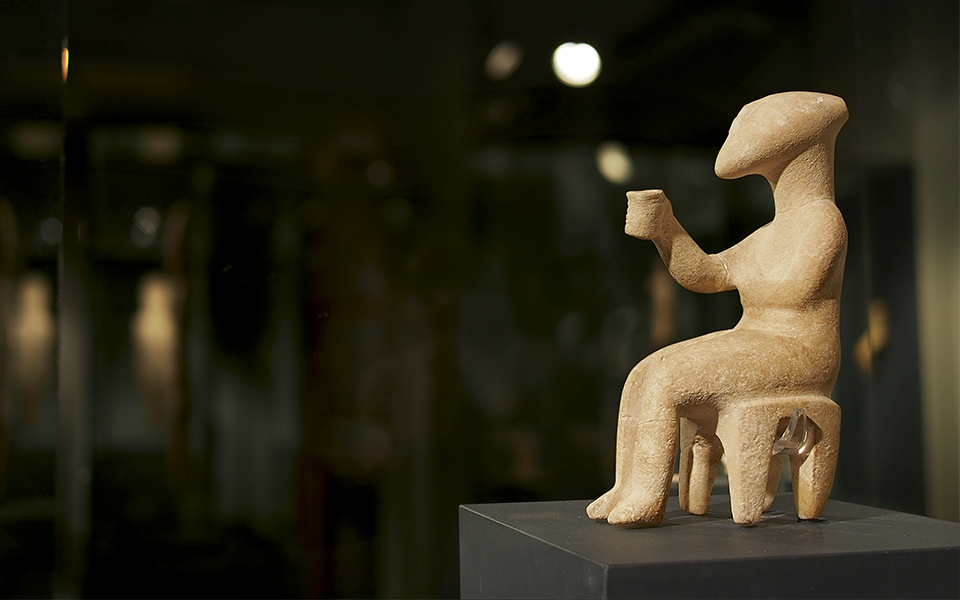
“Offering a Toast,” a rare type of marble figurine dating back to the Early Cycladic II period (2800-2300 BC). The figure sits on a stool and holds up a cup in his right hand, as if to offer a toast or a libation.
© Dimitris Tsoumplekas
Modern art is also the theme of two current temporary exhibitions at the nearby Museum of Cycladic Art (MCA). The show “Deste Prize: An Anniversary Exhibition 1999-2015,” which runs to September 17, presents the works of young contemporary artists, while “Divine Dialogues” (to September 3) explores the influence of Classical Antiquity on the work of the late American artist Cy Twombly through the juxtaposition of selected drawings and sculptures with ancient artifacts.
The MCA’s permanent collections focus on Cycladic Early Bronze Age culture (3rd millennium BC), highlighted by stunning marble figurines and other marble and bronze objects. On the upper floors, visitors are treated to excellent thematic displays, including an exhibit titled “Scenes from Daily Life in Antiquity,” which cover Greek culture from the Middle Bronze Age through the Roman era (4th c. AD). Also not to be missed is the MCA’s Cypriot collection, presented thematically and spanning millennia of rich Cypriot history.
4 Neophytou Douka, Kolonaki, tel. (+30) 210.722.8321-3
Open: Mon, Wed, Fri and Sat: 10:00- 17:00, Thu: 10:00-20:00, Sun: 11:00-17:00 (closed Tue)
General admission: €7 (Mon: €3.50)
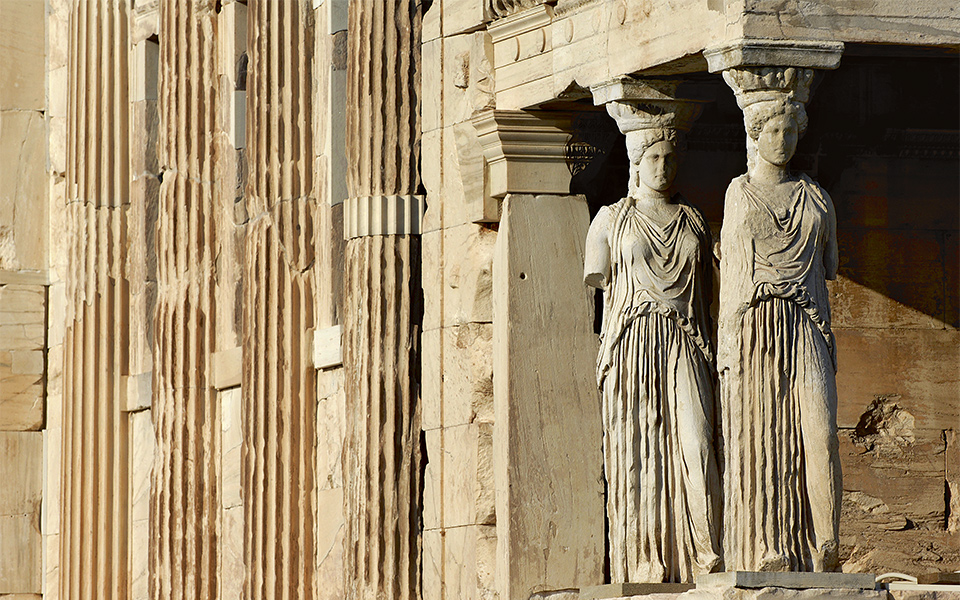
© Ministry of Culture and Sports/Ephorate of Antiquities of Athens
Ascending the Rockage to the Acropolis to admire the great Parthenon is essential, but there’s more to see here as well. Athena’s imposing Doric temple is unquestionably the star, but, as in the museums, attention must also be given to the small details of other, sometimes more evocative relics.
The Erechtheion, in the Parthenon’s northern shadow, also stands as a tribute to the Golden Age of Periclean Athens, but it offers its own distinctive architectural elegance and evidence of Classical ingenuity. Its architect, perhaps the innovative Mnesicles who designed the nearby Propylaia, brought together all the Acropolis’ traditional religious cults under one roof in a unique, composite structure smoothly adapted to uneven ground.
The Erechtheion features projecting colonnaded or Caryatid-adorned porches; finely carved but unfinished moldings (the sculptors’ work was interrupted by the Peloponnesian War); and “windows” in the North Porch’s roof and floor that (as ancient Greek art scholar Jeffrey Hurwit noted) allowed a direct metaphysical connection to be retained between the heavens above and the visible scars in the bedrock below – said to have been left by Zeus’ thunderbolt, hurled to Earth to interrupt the contest between Athena and Poseidon over rights to the city of Athens.
Ascending the Rock
Dionysiou Areopagitou, tel. (+30) 210.321.4172
Open daily: 8:00-20:00
General admission: €20
(There is also a €30 ticket allowing admission to all main archaeological sites in Athens.)
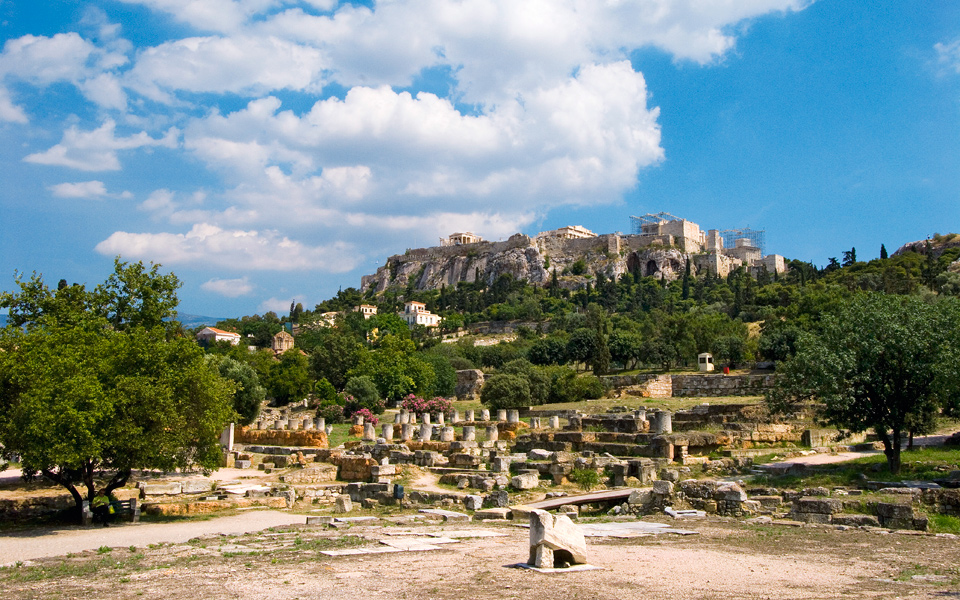
The Ancient Agora.
© Clairy Moustafellou
As one descends the Acropolis, passing the freshly restored Propylaia and the Temple of Athena Nike, a glance down to the right reveals the Athenian Agora, the central marketplace, political nucleus and popular meeting point for ancient Athenians. In addition to the Agora’s maze of fascinating ruins and an excellent small museum of daily ancient life in the resurrected Stoa of Attalos, the site also boasts the Temple of Hephaestus and Athena – known as the Hephaisteion (or Theseion) – which is remarkably well preserved.
Here, one gains a fuller sense of the impact that a towering Doric temple, strikingly similar to the contemporaneous Parthenon, made on the human consciousness some 2,500 years ago. The reason behind its stunning present-day condition was its early conversion (7th c. AD) to a Christian house of worship, the Church of Saint George. A stroll through the Agora takes you in the footsteps of Socrates, Pericles and other great historical characters.
Ancient Agora
24 Adrianou, tel. (+30) 210.321.0185
Open daily: 8:00-20:00
Admission: €8
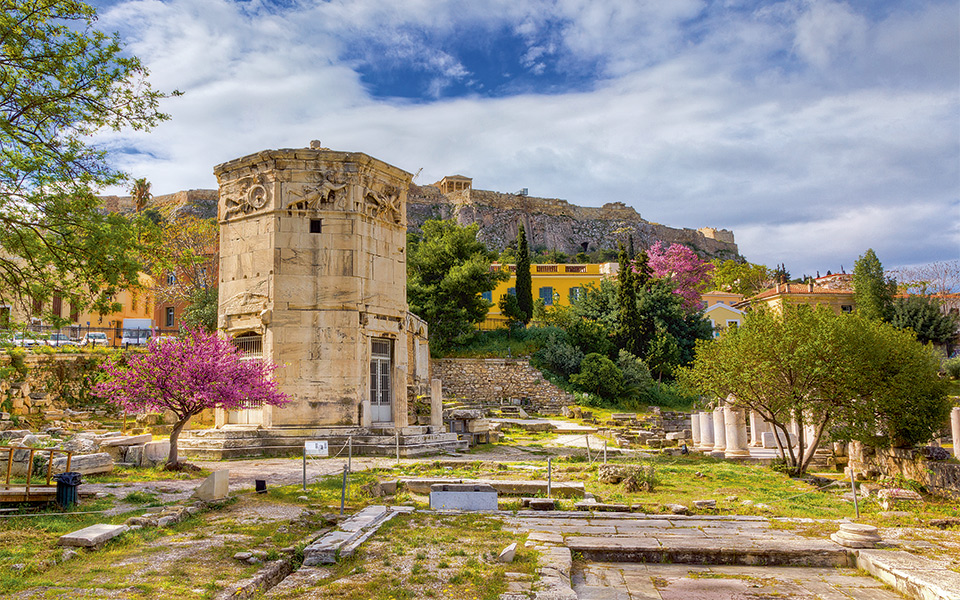
© Shutterstock, Ministry of Culture and Sports/Ephorate of Antiquities of Athens
The Romans, too, contributed to the architectural enhancement of ancient Athens, with Julius Caesar and his adopted nephew Augustus funding the establishment of a new agora, or forum, east of the original one. Among this market’s columns, visitors can spot shallow circular carvings in the steps, intended as standard measures for checking quantities of goods being exchanged, while faintly scratched inscriptions advertise the services or stake out the territory of prostitutes.
Of particular note is the octagonal Tower of the Winds, a focal point of the area and a monument to the ingenuity of ancient engineering. Once capped with a revolving bronze vane that pointed to relief-carved depictions of the eight winds, the tower served as both a public weather station and a time-piece: several sundials adorned its exterior walls, while a water-driven clock inside revealed the hour of the day even when the sky was overcast.
Roman Agora
Pelopida, Plaka, tel. (+30) 210.324.5220
Open daily: 8:00-17:00
General admission: €6
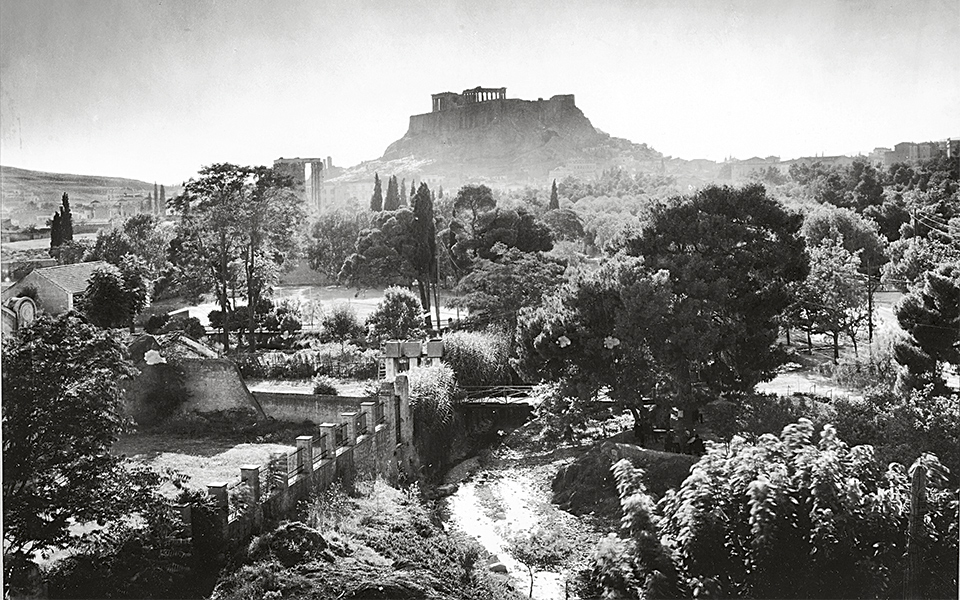
Verdant area around the river Ilissos, as captured by Frederic Boissonnas in 1910. distinguished the Olympieion and the Acropolis. From “Athens: The City, the People, the Events,” published by the Historical and Ethnological Society of Greece, Athens 2014. (Photographic Archive of the National Historical Museum 1859-1990)
© National Historical Museum of Athens
Like many ancient cities, Athens was dependent on natural springs, streams and piped-in water to keep a thirsty population sated. Traces of the city’s “rivers” (how much water they carried depended on the season) can be found at various sites. The Ilissos, descending from Mt. Hymettus and supplemented by the copious Kallirroe Spring, can still be seen adjacent to the Church of Agia Fotini (near the Olympieion), while a remnant of the city’s Hadrianic aqueduct survives at Dexameni (“Reservoir”) Square in Kolonaki.
Deep within the Monastiraki Metro Station, the gurgling sounds of Athens’ other main stream, the Eridanos, continue to fill the air as its waters flow through an ancient canalized, brick-vaulted channel, now on display for visitors and commuters.
The Eridanos River appears again at Kerameikos, the site of ancient Athens’ northwestern gates and its extra-mural cemetery. This peaceful, grassy archaeological park, crossed by the reedy, frog-inhabited Eridanos, is a welcome refuge in the center of the modern city, particularly in winter and spring.
Here you’ll find the Sacred Gate, opening toward the distant Demeter Sanctuary at Eleusis (Elefsina); the Pompeion and the Dipylon Gate, from which the annual Panathenaic Procession to the Acropolis began; and, most remarkably, an inconspicuous, walled tomb whose still-legible inscription identifies the historically ironic, state-sponsored burial of thirteen Spartan officers – in a cemetery ostensibly belonging to their arch-rivals.
The Athenian oligarchs of 403 BC, in trying to suppress the rebellious democrats led by Thrasybulus, had sought the aid of the equally anti-democratic Spartans and subsequently honored their dead officers with a proper burial after an unsuccessful battle in Piraeus.
Olympieion
Entrance from 1 Vasilissis Olgas, tel. (+30) 210.922.6330
Open daily: 8:00-20:00
Admission: €6
Monastiraki Metro Station, Monastiraki Square
Open: Sun- Thu 5:30-00:30; Fri, Sat: 5:30-02:30
Admission is the price of the Metro ticket (€1.40 full/€0.60 reduced)
Kerameikos
148 Ermou, tel. (+30) 210.346.3552
Open daily: 8:00-20:00
General admission: €8
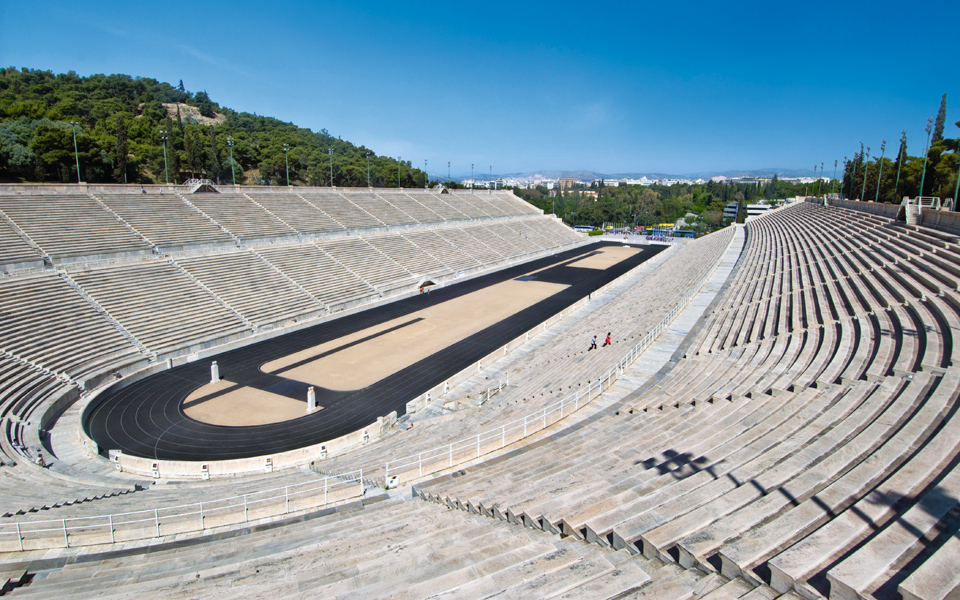
When the Panathenaic Stadium was first “marble-ized” by Herodes Atticus, it was said the lavish refurbishment had exhausted all the marble in Mt. Penteli’s quarries.
© Shutterstock
Contemporaneous with the Lysikrates Monument was the Panathenaic Stadium (ca. 330 BC), known today as the Kallimarmaro. Erected in a hollow between the hills of Agra and Ardettos on the southern bank of the Ilissos river, the horseshoe-shaped stadium was used for games held during religious celebrations such as the Panathenaic Festival.
Athletic competition and prowess were held in high esteem in Greco-Roman times, much like today, and the Kallimarmaro stands as an evocative tribute to those original ancient ideals. Completely veneered in white Pentelic marble by Herodes Atticus (2nd c. AD), the stadium eventually fell into decline, but it was unearthed in the 19th c. and splendidly re-marbled as a venue for the first modern Olympics in 1896.
Vasileos Konstantinou, tel. (+30) 210.752.2984
Open daily: 8:00-19:00
General admission: €5

The temple of Olympian Zeus, with the Acropolis in the background
© Effie Paroutsa
In addition to improving Athens’ water supply, the Roman emperor Hadrian, a renowned philhellene, also established what has come to be called his Library, near the Roman Agora. It may have been not only a repository for manuscripts and a center of learning, but also a new public forum – in a style similar to the imperial forums erected in Rome. (Later, in the 5th c. AD, an Early Christian tetraconch, or four-apsed, church was built in the Library’s central courtyard; it may have served as Athens’ first cathedral.)
In another act of imperial benefaction, Hadrian also completed the Temple of Olympian Zeus – more than 600 years after it was first laid out by the tyrant Peisistratus! Standing beside this gargantuan Corinthian temple, one cannot help but marvel, not only at the enormity of its scale but also at the scope of the imagination required from both Greeks and Romans for its conception and successful realization.
The Library of Hadrian
3 Areos and Adrianou, Monastiraki, tel. (+30) 210.324.9350
Open daily: 8:00-15:00
Admission: €4
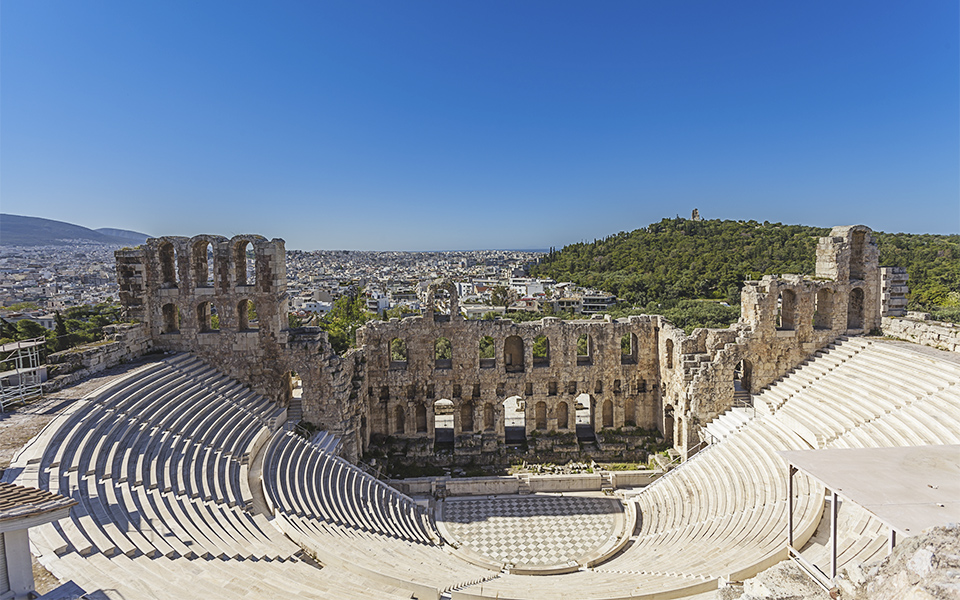
The Odeon of Herodes Atticus
© Shutterstock
Only a fraction the size of the Temple of Olympian Zeus, the Lysikrates Monument nevertheless casts a long shadow in the history of ancient Greek architecture. Once linked by a road to the Theater of Dionysus (the birthplace of drama) and the Odeon of Herodes Atticus, the Lysikrates Monument was originally flanked by other choregic monuments – self-aggrandizing tributes erected by theatrical producers to celebrate their victories in dramatic contests.
Today, it stands alone in Plaka, an expression of architectural innovation and cultural creativity – the earliest example (335 BC) of Corinthian-style columns in an exterior setting. Decorated with relief panels depicting Dionysus’ kidnapping pirates, whom he punitively transformed into dolphins, the hollow cylindrical structure was essentially an ornamental base for Lysikrates’ tripod prize. In 1669, it was incorporated into a Capuchin Franciscan friary and later converted into a small study used by Lord Byron (ca. 1810), when he temporarily resided at the monastery.
Today, music and theater enthusiasts can again appreciate great entertainment in the reconstructed Odeon of Herodes Atticus, during Athens’ annual summer festival.
For information on this season’s program, tickets, box offices and venues, visit www.greekfestival.gr
Tel. (+30) 210.928.2900
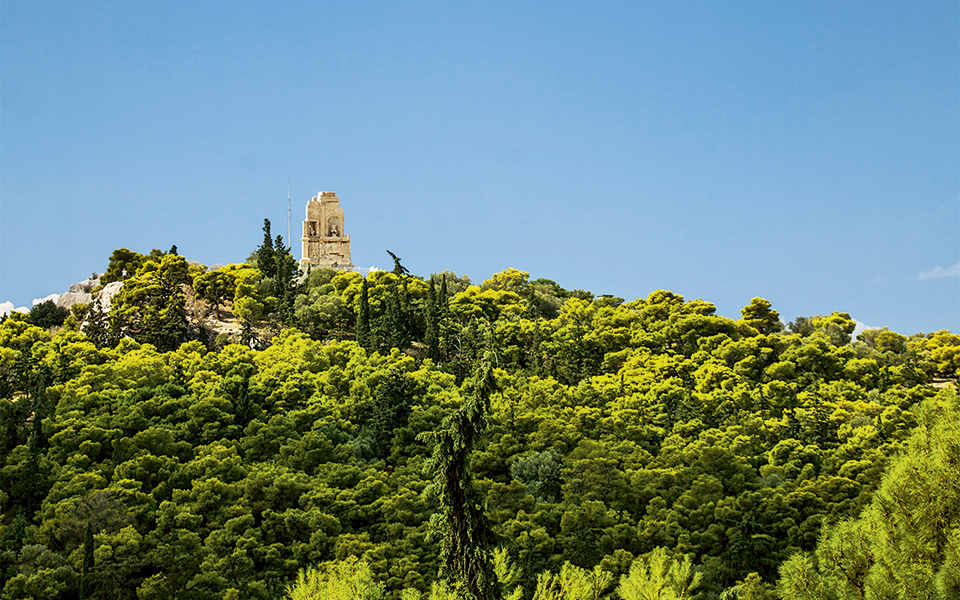
© Getty Images/Ideal Image
No one visiting Athens should miss the panoramic views from its numerous hills, which once represented religious and cultural focal points – places of worship, justice, democratic exercise and social recognition in the ancient city. West of the Acropolis are the Areopagus, Pnyx and Hill of the Muses (Filopappou Hill), home respectively to Athens’ highest court, its Popular Assembly (Ekklesia) and the monumental Roman-era tomb of Prince Gaius Philopappos, a respected royal refugee from the ancient Armenian kingdom of Commagene.
The wooded Ardettos Hill, beside the Kallimarmaro, was the site of a Temple of Tyche (Fortuna), whose foundations are still visible. Lykavittos’ ancient summit lay bare of temples, but today it’s crowned by the distinctive Church of Aghios Georgios (1870). Further away, the slopes of Mt Hymettus and Mt Penteli bear the discernible scars of ancient marble quarries.
A brave history and uniquely beautiful...
A summer mix of cultural events...
Step beyond Athens this autumn and...
Only a short drive from Athens,...